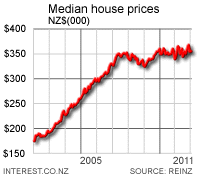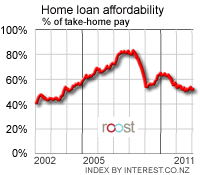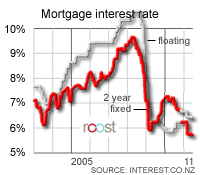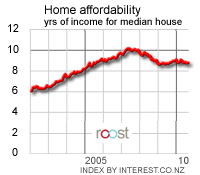 By Bernard Hickey Let's get this out of the way up front. I was wrong to predict a 30% fall in house prices by the end of 2010. I now expect house prices to fall 15% between the November 2007 peak and a trough in mid 2012, which means prices have a further 11% or so to fall from here.
By Bernard Hickey Let's get this out of the way up front. I was wrong to predict a 30% fall in house prices by the end of 2010. I now expect house prices to fall 15% between the November 2007 peak and a trough in mid 2012, which means prices have a further 11% or so to fall from here.  It's clear now that the housing market has not slumped as badly as I predicted it would back in March 2008 when I first forecast a fall of 20% to 30% over the next couple of years. I firmed up that forecast through late 2008 and early 2009 to say prices would fall 30% by the end of 2010. I still think house prices remain fundamentally over-valued by around 30%, but a collection of circumstances have changed so that now I think the fall will be shallower and take longer. I think house buyers and bankers are irrational enough to ensure the national median price measured by REINZ does not fall around 30% to around NZ$250,000 from the peak of NZ$352,000 in November 2007 as I originally predicted. The external factors that I thought would jolt the market back to reality have not happened and now look much less likely to happen.
It's clear now that the housing market has not slumped as badly as I predicted it would back in March 2008 when I first forecast a fall of 20% to 30% over the next couple of years. I firmed up that forecast through late 2008 and early 2009 to say prices would fall 30% by the end of 2010. I still think house prices remain fundamentally over-valued by around 30%, but a collection of circumstances have changed so that now I think the fall will be shallower and take longer. I think house buyers and bankers are irrational enough to ensure the national median price measured by REINZ does not fall around 30% to around NZ$250,000 from the peak of NZ$352,000 in November 2007 as I originally predicted. The external factors that I thought would jolt the market back to reality have not happened and now look much less likely to happen.  I now think the median is likely to fall to a trough of around NZ$300,000 by mid 2012, which is about 15% below the peak and 11% below the current level of NZ$337,500. It should then rise with incomes back to that November 2007 peak of NZ$352,000 by the end of 2016. That means those people who bought in 2006 expecting capital gains of 10% or more a year will not see any capital gains for 10 years. My view is not as pessimistic as it was, but it's still more pessimistic than most. Here's the 5 things that have changed since my March 2008 forecast that has prompted me to change my view.
I now think the median is likely to fall to a trough of around NZ$300,000 by mid 2012, which is about 15% below the peak and 11% below the current level of NZ$337,500. It should then rise with incomes back to that November 2007 peak of NZ$352,000 by the end of 2016. That means those people who bought in 2006 expecting capital gains of 10% or more a year will not see any capital gains for 10 years. My view is not as pessimistic as it was, but it's still more pessimistic than most. Here's the 5 things that have changed since my March 2008 forecast that has prompted me to change my view.
1. The world has not ended There was a period from March 2008 through to about May this year when there was a significant risk of a massive global financial meltdown. I have watched global financial markets for nearly 20 years and at various moments in March, September and November and again in February and March I saw things happen that I'd never seen before that made me worry about such a collapse. It's not that long ago, but some at the pinnacles of power, including Federal Reserve Chairman Ben Bernanke and then Treasury Secretary Henry Paulson, thought such a catastrophe was a real possibility. We may yet see something catastrophic, but the risks have abated. Bernanke, Paulson, his successor Tim Geithner, Barack Obama, Gordon Brown, the Bank of England and the European Central Bank have taken extraordinary steps to cut interest rates and pump printed money into the system to avert a catastrophe. Governments have nationalised banks. My caveat is that Europe's banks remain wildly over leveraged and have yet to take their medicine of massive losses and recapitalisations. Exchange rate collapses in Eastern Europe could yet cause a meltdown in Europe. America's banks are stable for now and are rebuilding their balance sheets by manufacturing profits out of various dubious trading activities funded with taxpayer money. They could still be tripped up. 2. Some green shoots are emerging Despite my initial skepticism, some green shoots are emerging in both the global economy and the local economy. Consumer and business confidence is returning in New Zealand, as is employment confidence. Unemployment remains low and is unlikely to rise much above 8%. Car sales have started rising in the last couple of months in New Zealand and there are some tentative signs that consumers have returned to the shops, although they are only tentative. Confidence in the house building industry is rebounding from very low levels and other builders of motorways, hospitals and schools are busy spending the government's money. Government spending on infrastructure is surging through the economy. America's economy has pulled out of a headlong dive and may start to grow, albeit feebly, by the end of this year or early next year. The threat of a full scale depression has receded, but the world's biggest economy now faces years of slow growth and a few double dips. Europe's outlook is much uglier and could be the catalyst for the global financial system tripping up again. China, however, looks to have weathered the storm reasonably well after its government spent up large and quickly. This is good news for us because Australia is so dependent on Chinese demand for its commodities, and we in turn are dependent on Australia. 3. New Zealand's banks are strong and back lending to property owners and farmers There were times during the December and March quarters when the big four banks got very nervous about their sources of new funding. Global financial markets froze for several weeks, raising the risk that the banks might not be able to roll over NZ$60 billion of foreign debt that have to be refinanced every 90 days or less. Kiwibank wrote more than 66% of all new mortgages in the December quarter because the banks slowed new lending dramatically. Interestingly, Kiwibank's growth has slowed sharply in recent months because it is not attacking with lower rates. The government owned banks is now capital constrained. The Reserve Bank moved aggressively in October and early November to help the big banks with some short term funding. Between November and May the Reserve Bank lent the banks NZ$8.25 billion in exchange for securitised mortgages. This helped fire up bank lending again. Bank lending to home owners has actually risen NZ$6 billion to NZ$164.2 billion since March last year. It has accelerated since January with an extra NZ$2.2 billion in lending through February, March, April and May. This has helped fuel demand from rental property investors looking to snap up what they viewed as bargains. Bankers have also reverted to a more conservative mode, preferred to lend against land and property rather than business cashflows. Business lending fell NZ$2.1 billion between November and May. 4. Interest rates fell the fastest and furthest in modern history  I was surprised at how quickly and deeply the Reserve Bank cut the Official Cash Rate. It cut the OCR from a record high 8.25% to a record low 2.5% between July and April. This helped drive the 6 month mortgage rate from around 9.6% to around 6.2%, which no doubt has helped boost rental investor demand. The Reserve Bank has worried openly about home buyers jumping back into the housing market and firing up the boom all over again. Cutting the OCR that much and that fast has helped stop the freefall. 5. Investors are falling in love with property again. The biggest savers in New Zealand have just had the biggest shock of their investment lives. Stock markets fell almost 50% at some points by early this year, while anyone with money in a finance company had a painful year. The most conservative savers now face earning less than 3% after tax if they leave their money in the bank. The OCR cuts corresponded with the 6 month term deposit rate falling from 8.45% to 3.93%. Many baby-boomers or those close to retirement are turning away completely from stocks, managed funds and bank accounts and hunting for better yields from property. So why am I saying prices will keep falling?
I was surprised at how quickly and deeply the Reserve Bank cut the Official Cash Rate. It cut the OCR from a record high 8.25% to a record low 2.5% between July and April. This helped drive the 6 month mortgage rate from around 9.6% to around 6.2%, which no doubt has helped boost rental investor demand. The Reserve Bank has worried openly about home buyers jumping back into the housing market and firing up the boom all over again. Cutting the OCR that much and that fast has helped stop the freefall. 5. Investors are falling in love with property again. The biggest savers in New Zealand have just had the biggest shock of their investment lives. Stock markets fell almost 50% at some points by early this year, while anyone with money in a finance company had a painful year. The most conservative savers now face earning less than 3% after tax if they leave their money in the bank. The OCR cuts corresponded with the 6 month term deposit rate falling from 8.45% to 3.93%. Many baby-boomers or those close to retirement are turning away completely from stocks, managed funds and bank accounts and hunting for better yields from property. So why am I saying prices will keep falling?  House prices remain fundamentally over valued, particularly at higher interest rates. I've revisited our home loan affordability series and used some assumptions about income growth and interest rates to work out where prices would go if over time affordability returned to the rational levels last seen in 2002. Some might argue that there's no impetus for the market to return to rationality, as much as I or anyone else might want it. But those people forget that interest rates will rise again back towards their long term average of around 8% and beyond, while unemployment will rise for at least another couple of years to close to 8%. Assuming a long term mortgage interest rate of 8% and continued income growth of 4% a year, housing would become affordable again when the median house price hits NZ$300,000 by mid 2012. I'm assuming a reasonable affordability level is interest costs equalling 40% of a single median disposable income with a 25 year mortgage and a loan to value ratio of 80%. Some might also argue that there's nothing to stop the banks from again borrowing cheaply overseas and flooding the market with cheap credit. That's less likely in the next couple of years because international capital flows have been restricted by the Credit Crunch and the Reserve Bank has imposed new limits ensuring foreign short term lending won't make up more than 25% of bank funding. At its peak in early 2008, the banks sourced more than 35% of their funding through this 'hot foreign money'. Another slump close to 2020? One final factor that I think will help pressure prices lower, particularly towards 2015, is the impending retirement of many baby-boomer home and rental property owners. At some stage that equity will have to be freed up. Your view? We welcome your comments below
House prices remain fundamentally over valued, particularly at higher interest rates. I've revisited our home loan affordability series and used some assumptions about income growth and interest rates to work out where prices would go if over time affordability returned to the rational levels last seen in 2002. Some might argue that there's no impetus for the market to return to rationality, as much as I or anyone else might want it. But those people forget that interest rates will rise again back towards their long term average of around 8% and beyond, while unemployment will rise for at least another couple of years to close to 8%. Assuming a long term mortgage interest rate of 8% and continued income growth of 4% a year, housing would become affordable again when the median house price hits NZ$300,000 by mid 2012. I'm assuming a reasonable affordability level is interest costs equalling 40% of a single median disposable income with a 25 year mortgage and a loan to value ratio of 80%. Some might also argue that there's nothing to stop the banks from again borrowing cheaply overseas and flooding the market with cheap credit. That's less likely in the next couple of years because international capital flows have been restricted by the Credit Crunch and the Reserve Bank has imposed new limits ensuring foreign short term lending won't make up more than 25% of bank funding. At its peak in early 2008, the banks sourced more than 35% of their funding through this 'hot foreign money'. Another slump close to 2020? One final factor that I think will help pressure prices lower, particularly towards 2015, is the impending retirement of many baby-boomer home and rental property owners. At some stage that equity will have to be freed up. Your view? We welcome your comments below

We welcome your comments below. If you are not already registered, please register to comment.
Remember we welcome robust, respectful and insightful debate. We don't welcome abusive or defamatory comments and will de-register those repeatedly making such comments. Our current comment policy is here.